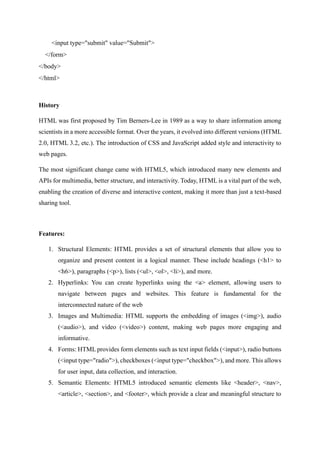HTML Overview
- 1. HTML HTML, or HyperText Markup Language, is a standard language used for creating and designing web pages. It's the backbone of web content and is essential for building and structuring web pages. Here are some key points about HTML: Definition: HTML is a markup language that uses tags to structure and format content on the web. It stands for HyperText Markup Language. Advantages: 1. Platform-Independent: HTML can be used on any device or platform with a web browser. 2. Easy to Learn: HTML is relatively simple to learn and use. 3. Widely Supported: All modern web browsers support HTML, making it a universal language for web development. 4. Structured Content: HTML provides a way to structure content with headings, paragraphs, lists, and more. 5. Accessibility: It allows for creating accessible content for people with disabilities through semantic tags and attributes. 6. Extensibility: You can add functionality through other web technologies, like CSS for styling and JavaScript for interactivity. Common HTML Tags: <html>: The root element of an HTML document. <head>: Contains metadata about the document. <title>: Sets the title of the web page. <body>: Contains the visible content of the web page. <h1>, <h2>, <h3>,...<h6>: Headings for organizing content.
- 2. <p>: Defines a paragraph. <a>: Creates hyperlinks. <img>: Embeds images. <ul> and <ol>: Create unordered and ordered lists, respectively. <li>: Represents list items. <div>: A container for grouping elements. <form>: Defines an input form. <input>: Creates various input fields. <button>: Adds clickable buttons. Creating simple form: <!DOCTYPE html> <html> <head> <title>Simple Form</title> </head> <body> <h1>Contact Us</h1> <form action="process_form.php" method="post"> <label for="name">Name:</label> <input type="text" id="name" name="name"><br> <label for="email">Email:</label> <input type="email" id="email" name="email"><br> <label for="message">Message:</label> <textarea id="message" name="message"></textarea><br>
- 3. <input type="submit" value="Submit"> </form> </body> </html> History HTML was first proposed by Tim Berners-Lee in 1989 as a way to share information among scientists in a more accessible format. Over the years, it evolved into different versions (HTML 2.0, HTML 3.2, etc.). The introduction of CSS and JavaScript added style and interactivity to web pages. The most significant change came with HTML5, which introduced many new elements and APIs for multimedia, better structure, and interactivity. Today, HTML is a vital part of the web, enabling the creation of diverse and interactive content, making it more than just a text-based sharing tool. Features: 1. Structural Elements: HTML provides a set of structural elements that allow you to organize and present content in a logical manner. These include headings (<h1> to <h6>), paragraphs (<p>), lists (<ul>, <ol>, <li>), and more. 2. Hyperlinks: You can create hyperlinks using the <a> element, allowing users to navigate between pages and websites. This feature is fundamental for the interconnected nature of the web 3. Images and Multimedia: HTML supports the embedding of images (<img>), audio (<audio>), and video (<video>) content, making web pages more engaging and informative. 4. Forms: HTML provides form elements such as text input fields (<input>), radio buttons (<input type="radio">), checkboxes (<input type="checkbox">), and more. This allows for user input, data collection, and interaction. 5. Semantic Elements: HTML5 introduced semantic elements like <header>, <nav>, <article>, <section>, and <footer>, which provide a clear and meaningful structure to
- 4. web content. These elements improve accessibility and search engine optimization (SEO). 6. Accessibility: HTML includes attributes and elements that support web accessibility, allowing web developers to create content that is usable and understandable by people with disabilities. 7. Global Attributes: HTML provides a set of global attributes that can be applied to most HTML elements, allowing you to add additional information, behavior, or styling to elements. 8. Cross-Browser Compatibility: HTML is widely supported by all major web browsers, making it a reliable and consistent choice for web development. 9. Extensibility: Developers can extend the functionality of HTML through various APIs (Application Programming Interfaces) and frameworks, allowing for integration with external services, databases, and more.




